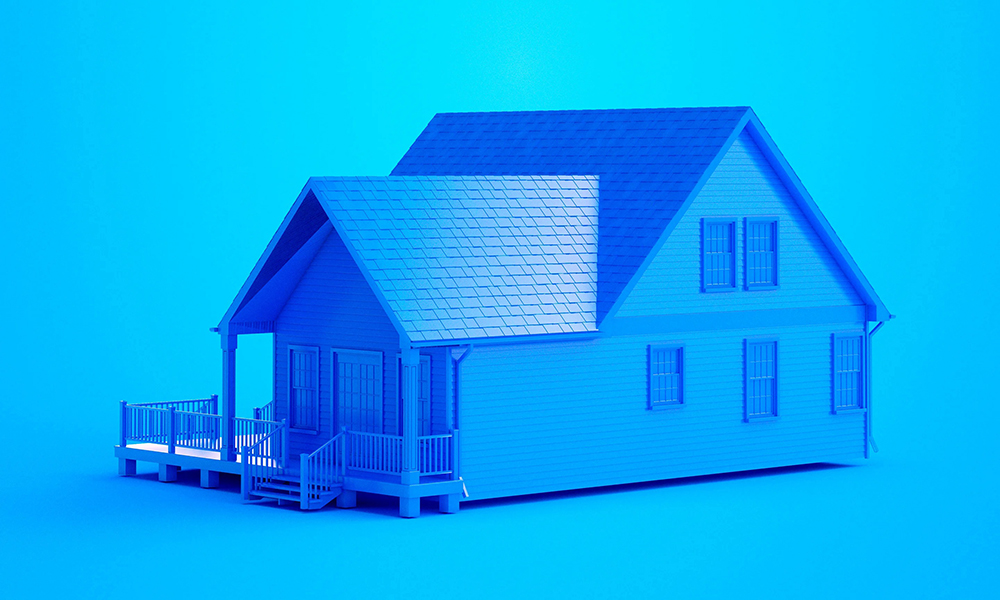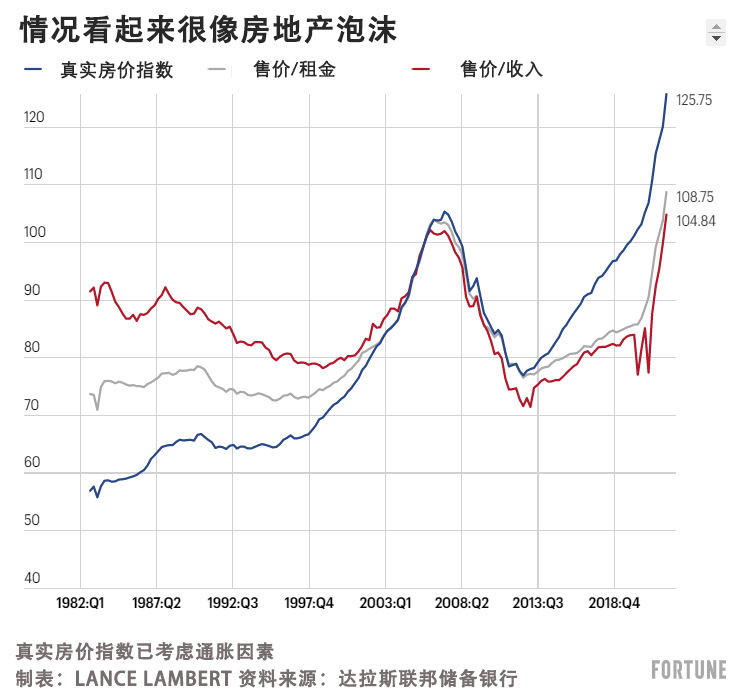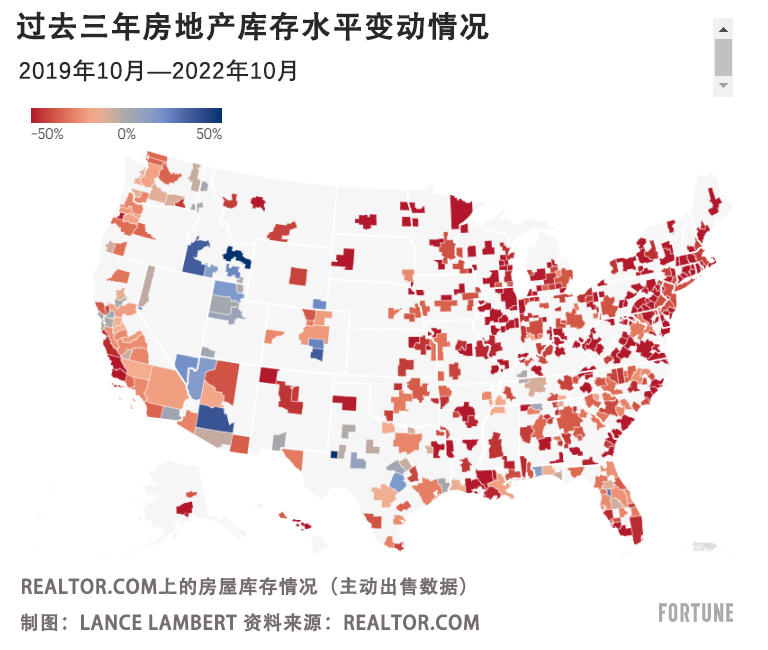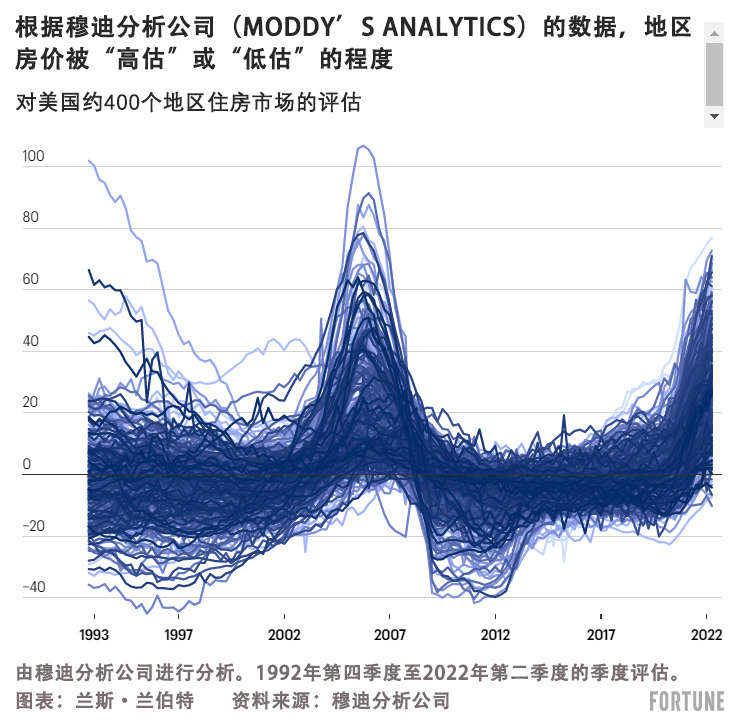
2005年的時候,美聯儲主席格林斯潘曾對國會表示:“美國整體上不太可能出現房價泡沫。”但是事實上,當時房地產泡沫不但已經形成了,而且就在格林斯潘在國會傳達這一信息時,泡沫已接近了頂峰。
時間快進到2022年,正是因為大家對上次泡沫心有余悸,所以這一次,經濟學家們并不害怕承認泡沫的存在——即便他們覺得這次泡沫或許沒有上一次那么危險。
上周二,全世界最有影響力的經濟學家就是這樣做的——美聯儲主席杰羅姆·鮑威爾在布魯金斯學會的一次活動中表示,美國在疫情期間的房價上漲就符合“房地產泡沫”的定義。
“由于疫情的緣故,當時的抵押貸款利率非常低,人們都想買房,而且是想離開城市,在郊區買房,所以美國確實出現了房地產泡沫,房價上漲到了非常不可持續的水平,出現了過熱等問題。所以,現在的房地產市場將迎來泡沫的另一階段,希望它的供需關系能達到一個更好的狀態。”鮑威爾說。
結合鮑威爾以往的發言,美國房地產的“平衡”進程應該已經開始了。今年6月份,鮑威爾曾表示,抵押貸款利率的大幅上漲將有助于“重置”美國的房地產市場。9月份鮑威爾曾對記者表示,美國已經正式進入了一個“艱難的房地產市場調整期”,它將恢復市場的“平衡”。
在鮑威爾承認有“泡沫”之前,達拉斯聯儲銀行在11月份發表了一篇題為《消除美國房地產泡沫是一項微妙而艱巨的任務》的文章。文章認為,美國的政策制定者應該努力讓泡沫縮水,而不是戳破它。
達拉斯聯儲銀行的馬丁內斯·加西亞在文中指出:“在當前的環境下,當住房需求出現疲軟跡象時,貨幣政策需要很小心地起到穿針引線的作用,既要下調通脹,同時也不能引發房價的螺旋式下跌——也就是不能引起住房市場的大拋售,那將加劇經濟下行。”加西亞還表示:“雖然形式充滿挑戰,但是災難性的崩盤并非不可避免,在縮小房市泡沫的同時實現美聯儲軟著陸目標的機會窗口仍然是存在的。”
為了更好地理解下一步房地產市場下一步將何去何從,我們可以深入研究一下鮑威爾關于房地產市場的言論。

客觀地說,美國房地產市場在疫情期間的確出現了泡沫。達拉斯聯儲銀行的數據顯示,2022年的美國房價實陸上比2005年和2008年更加脫離基本面。
未來一年內,房價與基本面的撕裂應該會有所愈合,這也是摩根士丹利、Zonda、畢馬威、約翰伯恩斯房地產咨詢、穆迪分析、高盛、富國、房利美和澤爾曼聯合公司等多家業內分析機構的共同意見。這些公司認為,隨著消費者的負擔壓力變大(在美國房價飆升40%之后,美國的抵押貸款利率也大幅上漲3%),美國的房價將在2023年進一步下跌。如果美國房價(目前已從2022年6月的最高點下跌2.2%)繼續下跌,而收入繼續上漲,則基本面將確實開始回歸現實。
不過,美聯儲的官員們并不認為目前的樓市調整是2008年的重演。
“從金融穩定性的角度來看,我們在這個周期內并未看到上次金融危機前的那種大規模的不良信貸。現在的貸款機構對住房信貸的管理要謹慎得多。所以2022年的情況是完全不同的,目前看來不存在金融穩定性的問題。但是我們也確實明白,房地產是影響我們政策的一個很大的方面。”鮑威爾在11月初對記者表示。
而上一次房地產泡沫則是另一幅景象。在上次房地產泡沫期間,貪婪的借貸機構會向有不良信貸記錄的借款人發放抵押貸款(更確切地說,是次級抵押貸款)。貸款的涌入促進了房地產市場的繁榮和房價上漲。但是隨著美聯儲收緊貸幣政策,美國在2006年出現了市場調整,房地產市場迅速出現供應過剩的局面,大量不良貸款無法償還,很多房子只能法拍了事。這種供給過剩和大量法拍房并存的局面,導致美國房價在2007年至2012年期間足足下跌了26%。
雖然美聯儲官員承認,美國房價有可能出現“實質性調整”,但他們并不認為這輪調整的破壞性會達到2008年的規模。原因是美聯儲認為未來幾年,我們不必擔心出現大規模的法拍房危機或者大規模的供給過剩。

由于房地產市場的高銷量和供應鏈問題疊加,導致疫情期間美國有大量住房項目未能按時交付。一方面,由于房地產商急于交房,這可能會加劇2023年的房價下行壓力。另一方面,這些房子尚不足以解決美國的住房短缺問題。鮑威爾也在上周三的講話中承認了這一點。
鮑威爾表示:“這些(批進行中的住房調整)都不會帶來影響長期的問題,因為美國是一個發達國家,建設中的住房數量是難以滿足公眾的需求的,所以住房短缺的情況長期看來仍然存在。”
因此,盡管抵押貸款利率的大幅上漲,有可能通過壓低房價的方式,給房地產市場帶來“平衡”,并且給進一步增長帶來一些去庫的空間,但是從長期看來,市場的軌跡可能仍然不利于買方。

我們還要明確一點——沒有人知道所謂的“房地產市場調整”將如何展開。需要解答的問題太多了。比如美國的通脹是否會快速下降,并且同時拉低抵押貸款利率?抑或通脹具有相當的粘性,因此還需要在更長的時間內維持較高的利率?
但有一點可以肯定,那就是根據歷史經驗,下一步的走向肯定是因地而異的。
這樣說的一個重要原因是,不同地區的基本面差異很大。以克利夫蘭和奧斯汀為例,前者在疫情期間出現了房地產繁榮,后者的房價更是飆升了70%以上。當然現在兩地的房地產市場已經發生了變化,奧斯汀已經出現了大幅回調(穆迪分析認為該地房價被“高估”了61%),而克里夫蘭只是房價增速略有放緩(穆迪分析認為該地房價被高估了15%)。
簡單地說就是,房地產市場的基本面仍然是很重要的。(財富中文網)
譯者:樸成奎
2005年的時候,美聯儲主席格林斯潘曾對國會表示:“美國整體上不太可能出現房價泡沫。”但是事實上,當時房地產泡沫不但已經形成了,而且就在格林斯潘在國會傳達這一信息時,泡沫已接近了頂峰。
時間快進到2022年,正是因為大家對上次泡沫心有余悸,所以這一次,經濟學家們并不害怕承認泡沫的存在——即便他們覺得這次泡沫或許沒有上一次那么危險。
上周二,全世界最有影響力的經濟學家就是這樣做的——美聯儲主席杰羅姆·鮑威爾在布魯金斯學會的一次活動中表示,美國在疫情期間的房價上漲就符合“房地產泡沫”的定義。
“由于疫情的緣故,當時的抵押貸款利率非常低,人們都想買房,而且是想離開城市,在郊區買房,所以美國確實出現了房地產泡沫,房價上漲到了非常不可持續的水平,出現了過熱等問題。所以,現在的房地產市場將迎來泡沫的另一階段,希望它的供需關系能達到一個更好的狀態。”鮑威爾說。
結合鮑威爾以往的發言,美國房地產的“平衡”進程應該已經開始了。今年6月份,鮑威爾曾表示,抵押貸款利率的大幅上漲將有助于“重置”美國的房地產市場。9月份鮑威爾曾對記者表示,美國已經正式進入了一個“艱難的房地產市場調整期”,它將恢復市場的“平衡”。
在鮑威爾承認有“泡沫”之前,達拉斯聯儲銀行在11月份發表了一篇題為《消除美國房地產泡沫是一項微妙而艱巨的任務》的文章。文章認為,美國的政策制定者應該努力讓泡沫縮水,而不是戳破它。
達拉斯聯儲銀行的馬丁內斯·加西亞在文中指出:“在當前的環境下,當住房需求出現疲軟跡象時,貨幣政策需要很小心地起到穿針引線的作用,既要下調通脹,同時也不能引發房價的螺旋式下跌——也就是不能引起住房市場的大拋售,那將加劇經濟下行。”加西亞還表示:“雖然形式充滿挑戰,但是災難性的崩盤并非不可避免,在縮小房市泡沫的同時實現美聯儲軟著陸目標的機會窗口仍然是存在的。”
為了更好地理解下一步房地產市場下一步將何去何從,我們可以深入研究一下鮑威爾關于房地產市場的言論。
客觀地說,美國房地產市場在疫情期間的確出現了泡沫。達拉斯聯儲銀行的數據顯示,2022年的美國房價實陸上比2005年和2008年更加脫離基本面。
未來一年內,房價與基本面的撕裂應該會有所愈合,這也是摩根士丹利、Zonda、畢馬威、約翰伯恩斯房地產咨詢、穆迪分析、高盛、富國、房利美和澤爾曼聯合公司等多家業內分析機構的共同意見。這些公司認為,隨著消費者的負擔壓力變大(在美國房價飆升40%之后,美國的抵押貸款利率也大幅上漲3%),美國的房價將在2023年進一步下跌。如果美國房價(目前已從2022年6月的最高點下跌2.2%)繼續下跌,而收入繼續上漲,則基本面將確實開始回歸現實。
不過,美聯儲的官員們并不認為目前的樓市調整是2008年的重演。
“從金融穩定性的角度來看,我們在這個周期內并未看到上次金融危機前的那種大規模的不良信貸。現在的貸款機構對住房信貸的管理要謹慎得多。所以2022年的情況是完全不同的,目前看來不存在金融穩定性的問題。但是我們也確實明白,房地產是影響我們政策的一個很大的方面。”鮑威爾在11月初對記者表示。
而上一次房地產泡沫則是另一幅景象。在上次房地產泡沫期間,貪婪的借貸機構會向有不良信貸記錄的借款人發放抵押貸款(更確切地說,是次級抵押貸款)。貸款的涌入促進了房地產市場的繁榮和房價上漲。但是隨著美聯儲收緊貸幣政策,美國在2006年出現了市場調整,房地產市場迅速出現供應過剩的局面,大量不良貸款無法償還,很多房子只能法拍了事。這種供給過剩和大量法拍房并存的局面,導致美國房價在2007年至2012年期間足足下跌了26%。
雖然美聯儲官員承認,美國房價有可能出現“實質性調整”,但他們并不認為這輪調整的破壞性會達到2008年的規模。原因是美聯儲認為未來幾年,我們不必擔心出現大規模的法拍房危機或者大規模的供給過剩。
由于房地產市場的高銷量和供應鏈問題疊加,導致疫情期間美國有大量住房項目未能按時交付。一方面,由于房地產商急于交房,這可能會加劇2023年的房價下行壓力。另一方面,這些房子尚不足以解決美國的住房短缺問題。鮑威爾也在上周三的講話中承認了這一點。
鮑威爾表示:“這些(批進行中的住房調整)都不會帶來影響長期的問題,因為美國是一個發達國家,建設中的住房數量是難以滿足公眾的需求的,所以住房短缺的情況長期看來仍然存在。”
因此,盡管抵押貸款利率的大幅上漲,有可能通過壓低房價的方式,給房地產市場帶來“平衡”,并且給進一步增長帶來一些去庫的空間,但是從長期看來,市場的軌跡可能仍然不利于買方。
我們還要明確一點——沒有人知道所謂的“房地產市場調整”將如何展開。需要解答的問題太多了。比如美國的通脹是否會快速下降,并且同時拉低抵押貸款利率?抑或通脹具有相當的粘性,因此還需要在更長的時間內維持較高的利率?
但有一點可以肯定,那就是根據歷史經驗,下一步的走向肯定是因地而異的。
這樣說的一個重要原因是,不同地區的基本面差異很大。以克利夫蘭和奧斯汀為例,前者在疫情期間出現了房地產繁榮,后者的房價更是飆升了70%以上。當然現在兩地的房地產市場已經發生了變化,奧斯汀已經出現了大幅回調(穆迪分析認為該地房價被“高估”了61%),而克里夫蘭只是房價增速略有放緩(穆迪分析認為該地房價被高估了15%)。
簡單地說就是,房地產市場的基本面仍然是很重要的。(財富中文網)
譯者:樸成奎
In 2005, Fed Chair Alan Greenspan told Congress that a “bubble in home prices for the nation as a whole does not appear likely.” Of course, not only had a housing bubble formed, it was nearing its peak just as Greenspan delivered that message on Capitol Hill.
Fast forward to 2022, and the scars of the last bubble have clearly made economists less afraid to acknowledge a housing bubble—even if they believe the bubble could be less dangerous than the one that formed in the early 2000s.
On Tuesday, the most powerful economist in the world did just that: Speaking at a Brookings Institute event, Fed Chair Jerome Powell told the audience that the run-up in home prices during the Pandemic Housing Boom qualifies a “housing bubble.”
“Coming out of the pandemic, [mortgage] rates were very low, people wanted to buy houses, they wanted to get out of the cities and buy houses in the suburbs because of COVID. So you really had a housing bubble, you had housing prices going up [at] very unsustainable levels and overheating and that kind of thing. So, now the housing market will go through the other side of that and hopefully come out in a better place between supply and demand,” Powell said.
According to past statements by Powell, that process of bringing “balance” to the U.S. housing market has already begun. In June, Powell said spiked mortgage rates would help to “reset” the U.S. housing market. Then in September, Powell told reporters that we had officially entered into a “difficult [housing] correction” that would restore “balance” to the market.
That “bubble” acknowledgment by Powell comes on the heels of an article published in November by the Federal Reserve Bank of Dallas with the title “Skimming U.S. Housing Froth a Delicate, Daunting Task.” The article argued that policymakers should try to deflate the bubble rather than burst it.
“In the current environment, when housing demand is showing signs of softening, monetary policy needs to carefully thread the needle of bringing inflation down without setting off a downward house-price spiral—a significant housing sell-off—that could aggravate an economic downturn,” writes Martínez-García at the Dallas Fed. “A severe housing bust from the frothy pandemic run-up isn’t inevitable. Although the situation is challenging, there remains a window of opportunity to deflate the housing bubble while achieving the Fed’s preferred outcome of a soft landing.”
To better understand where we might head next, let’s take a deeper examination of Powell’s housing comments.
The U.S. housing market got objectively bubbly during the pandemic. In fact, data produced by the Dallas Fed (see chart above) finds that home prices in 2022 are actually more detached from underlying fundamentals than they were 2005 and 2008.
Over the coming year, those detached fundamentals should begin to heal a bit. That's a view held by firms like Morgan Stanley, Zonda, KPMG, John Burns Real Estate Consulting, Moody's Analytics, Goldman Sachs, Wells Fargo, Fannie Mae, and Zelman & Associates. Those firms believe that "pressurized" affordability (i.e. mortgage rates spiking 3 percentage points just after U.S. home prices soared 40%) will see home prices fall further in 2023. If U.S. home prices—which are already down 2.2% from their June 2022 peak—continue to fall and incomes continue to rise, fundamentals would indeed begin to come back down to earth.
That said, Fed officials don't think the ongoing housing correction is a 2008 repeat.
"From a financial stability standpoint, we didn't see in this cycle the kinds of poor underwriting credit that we saw before the Great Financial Crisis. Housing credit was much more carefully managed by the lenders. It's a very different situation [in 2022], it doesn't present potential, [well] it doesn't appear to present financial stability issues. But we do understand that [housing] is where a very big effect of our policies is," Powell told reporters earlier in November.
See, the last housing bubble was fundamentally a different story. Back in the aughts, zealous lenders were giving out mortgages (or better put, subprime mortgages) to folks who historically wouldn’t have qualified. As that credit rushed in, it helped to drive both a building boom and a home price boom. However, once Fed tightening set off a housing market correction in 2006, that building boom turned into a supply glut and those bad loans turned into a foreclosure crisis. That combination of oversupply and "forced selling" saw U.S. home prices fall a staggering 26% between 2007 and 2012.
While Fed officials acknowledge that we could see a "material correction" in home prices, they don't believe it'd be as damaging as the 2008 crash. The reason? In the years ahead, the Fed believes we shouldn't have to worry about a foreclosure crisis nor a massive supply glut.
A combination of high sales and supply chain issues saw home builders build-up quite a backlog of unfinished projects during the pandemic. On one hand, as homebuilders rush to offload these homes that could put downward pressure on home prices in 2023. On the other hand, this simply isn't enough homes to solve the nation's housing shortage. Powell acknowledged as much on Wednesday.
"None of this [the ongoing housing correction] affects the longer run issue, which is that we got a built-up country and it's hard to get zoning and hard to get housing built in sufficient quantities to meet the public's demand," Powell. "There's a longer run housing shortage."
So while spiked mortgage rates may help to bring "balance" to the housing market by pushing home prices lower and giving inventory (see chart above) breathing room to grow, the trajectory of the market might not favor buyers for long.
Let's be clear: No one really knows how the ongoing housing correction will actually unfold. There are simply too many question marks. Does inflation come down quickly and bring mortgage rates down with it? Or does inflation prove sticky, and thus require higher rates for longer?
But we can say, based on past history, whatever comes next will surely vary by housing market.
One big reason that it'll vary is that fundamentals vary so much by market. Look no further than Cleveland and Austin. The former saw a modest housing boom during the pandemic, while the latter saw home prices soar over 70%. Of course, now that the housing market has shifted, Austin (which Moody's Analytics estimates is "overvalued" by 61%) has already slipped into a sharp correction while Cleveland (which is "overvalued" by 15%) has simply slowed down.
Simply put: Housing fundamentals still matter.






